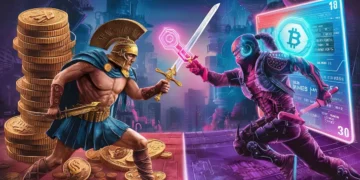Four major Web3 gaming projects shut down within a week, sending the entire industry into a frenzy. This wave of closures is a harsh reminder of the need to strike a balance between blockchain and gameplay.
Key Takeaways
-
The closures draw attention to unsustainable funding models and unrealistic timelines.
-
Market metrics and weak token liquidity lead to a major drop in player engagement.
-
Celebrity-driven hype collapsed without solid tokenomics.
-
Migration and platform risks exposed vulnerabilities.
-
Community-driven, skill-based design is vital for future stability.
What Is Web3 Gaming?
Web3 gaming refers to titles that integrate blockchain elements—such as NFTs, tokens, or smart contracts—into traditional gameplay loops. By leveraging decentralized technologies, these games promise ownership of in-game assets and potential rewards. However, recent events underscore that strong gameplay fundamentals must come before any token-driven mechanics.
Why Four Major Web3 Projects Shut Down
Tatsumeeko: Lumina Fates – Ambition Meets Reality
Tatsumeeko: Lumina Fates, developed by Singapore-based Tatsu Works, raised $7.5 million to build a 2.5D RPG with deep social features and housing systems.
Multiple playtests and a move from Immutable X/Solana to Ronin revealed that scope creep overwhelmed their ability to deliver. After the abrupt closure, allegations of a so-called “rug pull” surfaced online—a term often used in the crypto space to describe projects that unexpectedly shut down and leave backers empty-handed. However, Tatsu Works has since pivoted to a new Discord-integrated project called Wander.
Nyan Heroes – The Funding Paradox
Solana-based Nyan Heroes secured $13 million across funding rounds, yet failed to maintain player retention following its fourth playtest. The game attracted over one million total players and tallied 250,000 wishlists across major platforms. However, the inability to reach new funding milestones signalled its downfall. With Web3 gaming investments at four-year lows, 9 Lives Interactive ran out of capital to stay afloat.
Blast Royale – Open-Sourcing as an Exit Strategy
Blast Royale by First Light Games chose to open-source its codebase after struggling to stabilize its in-game economy. Despite receiving $5 million in funding, the team’s token generation event failed to prevent financial losses. By releasing the code on June 1, 2025, the developers preserved a degree of community ownership and offered a blueprint for others to build upon.
Rumble Kong League – Celebrity Hype vs. Tokenomics
Rumble Kong League, endorsed by basketball star Steph Curry, collapsed due to failing tokenomics. Its $FAME token launched with minimal liquidity and rapidly lost value. Development stalled, community moderators went unpaid, and the NFT Kongs—once valued at over $1,600—now trade at a fraction of their original price. This stark decline shows how celebrity-driven buzz can’t mask deeper structural issues.
Core Challenges in Web3 Gaming
Overfunding Pitfalls
During the crypto boom of 2021–2024, many projects raised large sums based on promising concepts rather than proven gameplay. Unrealistic valuations forced teams to chase user metrics to satisfy investors, which often led to quick expansions that were difficult to sustain.
Token Liquidity Dilemmas
Tokens like Rumble Kong League’s $FAME or Blast Royale’s $NOOB failed to strike a balance between gameplay utility and stable value. When speculation overshadows skill-based rewards, players tend to abandon ship at the earliest sign of an economic downturn.
Platform Dependency
Several games anchored themselves to a single blockchain. Tatsumeeko’s pivot to Ronin and Nyan Heroes’ focus on Solana left them exposed to declining user bases on those platforms. Cross-chain flexibility is becoming a requirement for resilience.
Preventing Future Failures
To minimize risk and foster healthier growth, developers and investors are adopting new strategies:
Skill-Based Rewards
Emphasizing challenge-driven gameplay over quick monetary gains keeps players engaged for longer periods.
Sustainable Funding Models
Replacing massive seed rounds with phased, performance-linked investments can ensure projects scale at a manageable rate.
Open-Source Initiatives
Projects like Blast Royale show how releasing code to the community can sustain development momentum, even if the original studio steps back.
Cross-Chain Collaboration
Supporting multiple blockchains protects games from single-platform declines and widens player access.
Community-Centric Design
Tatsu Works’ pivot shows that listening to user feedback and genuine engagement is key to establishing a durable Web3 gaming ecosystem.
Frequently Asked Questions (FAQ)
Q1: Are these closures a sign that Web3 gaming is dead?
Not necessarily. Industry experts believe these failures serve as a necessary correction. The sector is refining its focus on strong gameplay and sustainable token models.
Q2: Why is tokenomics important in Web3 gaming?
Tokens can directly impact player motivation and game economies. Misaligned incentives cause volatility and retention problems. We need balanced systems.
Q3: What can developers learn from these shutdowns?
Devs should prioritize gameplay quality, plan funding structures carefully and be agile with cross-chain support. Relying on external hype or short-term profit can undermine long-term success.
Q4: Is open-sourcing game code a viable exit strategy?
It can be. By releasing the source code, studios like First Light Games allow community innovation to continue. This approach aligns with the decentralized ethos of Web3.
Q5: How can players protect themselves from risky Web3 gaming investments?
Users should research team credentials, tokenomics and community sentiment before committing funds. Be realistic in an emerging sector.
Conclusion
The sudden shutdown of four well-funded Web3 games in a single week underscores the challenges game developers face when merging blockchain tech with engaging gameplay. Despite large investment rounds and celebrity endorsements, flawed token models, inadequate funding plans, and platform limitations accelerated these failures.
Still, the lessons learned push the industry to embrace user-focused strategies, better funding frameworks, and stronger cross-chain resilience. In this way, recent closures might spark a more mature era for Web3 gaming—one defined by skill-based experiences and authentic player ownership.
Four major Web3 gaming projects shut down within a week, sending the entire industry into a frenzy. This wave of closures is a harsh reminder of the need to strike a balance between blockchain and gameplay.
Key Takeaways
-
The closures draw attention to unsustainable funding models and unrealistic timelines.
-
Market metrics and weak token liquidity lead to a major drop in player engagement.
-
Celebrity-driven hype collapsed without solid tokenomics.
-
Migration and platform risks exposed vulnerabilities.
-
Community-driven, skill-based design is vital for future stability.
What Is Web3 Gaming?
Web3 gaming refers to titles that integrate blockchain elements—such as NFTs, tokens, or smart contracts—into traditional gameplay loops. By leveraging decentralized technologies, these games promise ownership of in-game assets and potential rewards. However, recent events underscore that strong gameplay fundamentals must come before any token-driven mechanics.
Why Four Major Web3 Projects Shut Down
Tatsumeeko: Lumina Fates – Ambition Meets Reality
Tatsumeeko: Lumina Fates, developed by Singapore-based Tatsu Works, raised $7.5 million to build a 2.5D RPG with deep social features and housing systems.
Multiple playtests and a move from Immutable X/Solana to Ronin revealed that scope creep overwhelmed their ability to deliver. After the abrupt closure, allegations of a so-called “rug pull” surfaced online—a term often used in the crypto space to describe projects that unexpectedly shut down and leave backers empty-handed. However, Tatsu Works has since pivoted to a new Discord-integrated project called Wander.
Nyan Heroes – The Funding Paradox
Solana-based Nyan Heroes secured $13 million across funding rounds, yet failed to maintain player retention following its fourth playtest. The game attracted over one million total players and tallied 250,000 wishlists across major platforms. However, the inability to reach new funding milestones signalled its downfall. With Web3 gaming investments at four-year lows, 9 Lives Interactive ran out of capital to stay afloat.
Blast Royale – Open-Sourcing as an Exit Strategy
Blast Royale by First Light Games chose to open-source its codebase after struggling to stabilize its in-game economy. Despite receiving $5 million in funding, the team’s token generation event failed to prevent financial losses. By releasing the code on June 1, 2025, the developers preserved a degree of community ownership and offered a blueprint for others to build upon.
Rumble Kong League – Celebrity Hype vs. Tokenomics
Rumble Kong League, endorsed by basketball star Steph Curry, collapsed due to failing tokenomics. Its $FAME token launched with minimal liquidity and rapidly lost value. Development stalled, community moderators went unpaid, and the NFT Kongs—once valued at over $1,600—now trade at a fraction of their original price. This stark decline shows how celebrity-driven buzz can’t mask deeper structural issues.
Core Challenges in Web3 Gaming
Overfunding Pitfalls
During the crypto boom of 2021–2024, many projects raised large sums based on promising concepts rather than proven gameplay. Unrealistic valuations forced teams to chase user metrics to satisfy investors, which often led to quick expansions that were difficult to sustain.
Token Liquidity Dilemmas
Tokens like Rumble Kong League’s $FAME or Blast Royale’s $NOOB failed to strike a balance between gameplay utility and stable value. When speculation overshadows skill-based rewards, players tend to abandon ship at the earliest sign of an economic downturn.
Platform Dependency
Several games anchored themselves to a single blockchain. Tatsumeeko’s pivot to Ronin and Nyan Heroes’ focus on Solana left them exposed to declining user bases on those platforms. Cross-chain flexibility is becoming a requirement for resilience.
Preventing Future Failures
To minimize risk and foster healthier growth, developers and investors are adopting new strategies:
Skill-Based Rewards
Emphasizing challenge-driven gameplay over quick monetary gains keeps players engaged for longer periods.
Sustainable Funding Models
Replacing massive seed rounds with phased, performance-linked investments can ensure projects scale at a manageable rate.
Open-Source Initiatives
Projects like Blast Royale show how releasing code to the community can sustain development momentum, even if the original studio steps back.
Cross-Chain Collaboration
Supporting multiple blockchains protects games from single-platform declines and widens player access.
Community-Centric Design
Tatsu Works’ pivot shows that listening to user feedback and genuine engagement is key to establishing a durable Web3 gaming ecosystem.
Frequently Asked Questions (FAQ)
Q1: Are these closures a sign that Web3 gaming is dead?
Not necessarily. Industry experts believe these failures serve as a necessary correction. The sector is refining its focus on strong gameplay and sustainable token models.
Q2: Why is tokenomics important in Web3 gaming?
Tokens can directly impact player motivation and game economies. Misaligned incentives cause volatility and retention problems. We need balanced systems.
Q3: What can developers learn from these shutdowns?
Devs should prioritize gameplay quality, plan funding structures carefully and be agile with cross-chain support. Relying on external hype or short-term profit can undermine long-term success.
Q4: Is open-sourcing game code a viable exit strategy?
It can be. By releasing the source code, studios like First Light Games allow community innovation to continue. This approach aligns with the decentralized ethos of Web3.
Q5: How can players protect themselves from risky Web3 gaming investments?
Users should research team credentials, tokenomics and community sentiment before committing funds. Be realistic in an emerging sector.
Conclusion
The sudden shutdown of four well-funded Web3 games in a single week underscores the challenges game developers face when merging blockchain tech with engaging gameplay. Despite large investment rounds and celebrity endorsements, flawed token models, inadequate funding plans, and platform limitations accelerated these failures.
Still, the lessons learned push the industry to embrace user-focused strategies, better funding frameworks, and stronger cross-chain resilience. In this way, recent closures might spark a more mature era for Web3 gaming—one defined by skill-based experiences and authentic player ownership.





















































































can i purchase generic clomiphene online generic clomid pill can you get clomid without a prescription buying cheap clomiphene no prescription where can i buy clomid how can i get generic clomid tablets how can i get generic clomid tablets
This is the gentle of writing I positively appreciate.
The depth in this piece is exceptional.
brand azithromycin 250mg – floxin 400mg cost flagyl 200mg without prescription
semaglutide medication – cheap rybelsus 14 mg buy periactin for sale
domperidone 10mg cheap – sumycin 250mg canada order flexeril generic
where can i buy clavulanate – https://atbioinfo.com/ purchase ampicillin
buy cheap generic esomeprazole – https://anexamate.com/ order esomeprazole pills
how to buy medex – https://coumamide.com/ hyzaar online
buy mobic sale – https://moboxsin.com/ order mobic 7.5mg online cheap
order prednisone 5mg pill – https://apreplson.com/ deltasone 40mg generic
buy ed pills cheap – https://fastedtotake.com/ ed pills that work quickly
buy cheap amoxicillin – comba moxi amoxil online order
order escitalopram 10mg pills – https://escitapro.com/ lexapro 20mg generic
cenforce order online – on this site purchase cenforce sale
where to buy cialis in canada – https://ciltadgn.com/# cialis vs flomax
cialis price comparison no prescription – https://strongtadafl.com/# cialis generic overnite
generic zantac 150mg – https://aranitidine.com/ buy zantac sale
order cheap generic viagra – https://strongvpls.com/# order viagra boots
This is the kind of glad I enjoy reading. https://buyfastonl.com/amoxicillin.html
This website positively has all of the tidings and facts I needed to this case and didn’t positive who to ask. site
This website absolutely has all of the tidings and facts I needed there this case and didn’t know who to ask. https://ursxdol.com/amoxicillin-antibiotic/
This is the description of content I enjoy reading. https://prohnrg.com/
The thoroughness in this section is noteworthy. on this site
Proof blog you be undergoing here.. It’s hard to espy elevated worth article like yours these days. I truly recognize individuals like you! Withstand mindfulness!! https://ondactone.com/product/domperidone/
I’ll certainly carry back to review more.
methotrexate brand
More posts like this would create the online time more useful. http://www.mrpretzels.com/locations/redirect.aspx?name=Canada&url=https://www.storeboard.com/xpregain
I am in truth happy to gleam at this blog posts which consists of tons of worthwhile facts, thanks representing providing such data. http://ledyardmachine.com/forum/User-Toynck
buy forxiga pills – on this site forxiga order online
xenical pills – on this site order orlistat 120mg for sale
More articles like this would frame the blogosphere richer. https://www.forum-joyingauto.com/member.php?action=profile&uid=49459